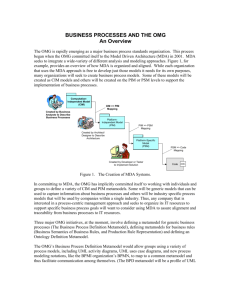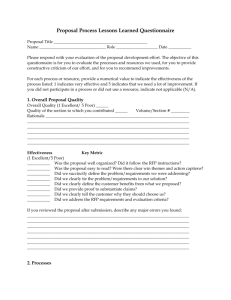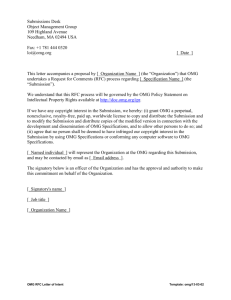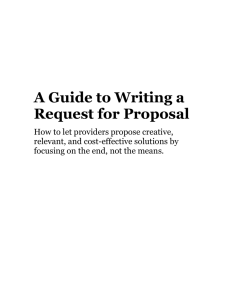OMG Software Services Profile and Metamodel RFP Object
advertisement
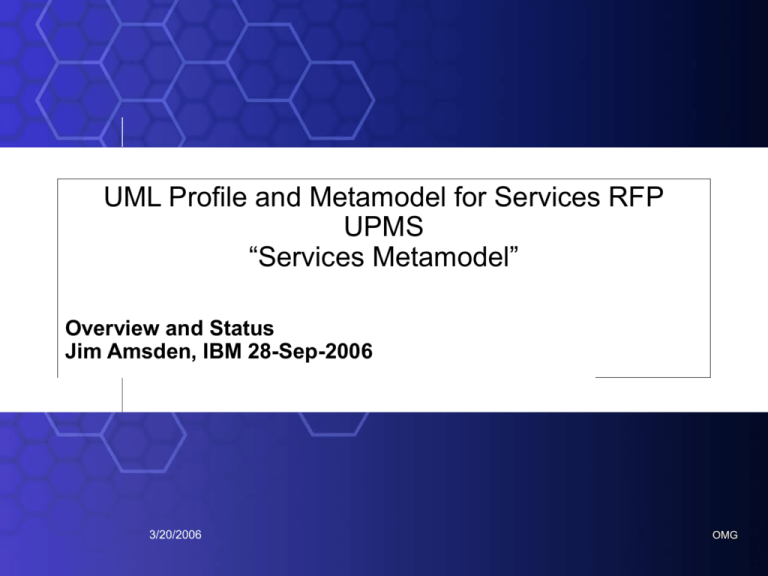
UML Profile and Metamodel for Services RFP UPMS “Services Metamodel” Overview and Status Jim Amsden, IBM 28-Sep-2006 3/20/2006 OMG Object Management Group Problem Statement – Standards driven by business needs Globalization, rapid change, the Internet and the “Flat World” stimulating business innovation and integration – Each business unit to focus on their key value while leveraging capabilities provided by others for non-core functions – Requires business agility to respond to market opportunities and challenges Evolution in the business parallels evolution in IT solutions – Complexity Management – The ability to respond to dynamic change – Modularity – Encapsulation – Separation and integration of concerns – Deferred commitment – Solutions through composition of other solutions – Adaptability – Reuse Each evolutionary step introduces additional capabilities for separation of concerns, loose coupling, and late binding OMG Software Services Profile and Metamodel RFP Object Management Group Facing Business and IT challenges requires SOA A framework for matching needs and capabilities, and combining capabilities to meet needs through services A foundation enabling business agility and adaptability Promote reuse, growth and interoperability to realize the value inherent in individual assets Reflects continuing evolution of computing models to enable reuse and reduce coupling Greater focus on separation of concerns and delegation Minimize trust and connection assumptions – Ownership, distribution and implementation OMG Software Services Profile and Metamodel RFP Object Management Group BPM and SOA can help realize business agility Clear separation of the Business operations from services solutions Enable integration at the business and IT solution levels independently BPM captures and validates business organizational and operational requirements and constraints SOA enables flexible solutions to business requirements OMG Software Services Profile and Metamodel RFP Object Management Group But there is a proliferation of protocols, specifications, metamodels and tools Many are incompatible with each other SOA platforms are in immature and rapidly changing OASIS SOA Reference Model has only just been completed As a result it will be harder for companies to realize the BPM and SOA potential Without costly conversion tools and runtime adapters and mediators – Higher development costs – Requirement for more skilled developers – Bloat in both development and runtime platforms – Increased potential for bugs OMG Software Services Profile and Metamodel RFP Object Management Group What is needed is a new Services Standard Enable interoperability and integration at the model level At a higher-level of abstraction separate from platform variability Address business integration and service interaction concerns at the architectural level – Architecture is the bridge between the business requirements and IT solutions Enable SOA on existing platforms through MDA Allows for flexible platform choices While preventing existing solutions from inhibiting platform evolution Leverage and integrate with existing OMG standards for end-to-end lifecycle development and management OMG Software Services Profile and Metamodel RFP Object Management Group Why WS-* is too much and not enough Semantically thin specifications Rapidly evolving specifications, likely to be more churn Relatively low-level abstraction rooted in XML – Communication may be local or remote Focused on wire protocols, data interchange, and execution environments Represent only one of may possible SOA realizations Many standards focused on individual technology segments Interdependencies and relationships result from overlaps and gaps – Leads to vendor variability and interoperability issues OMG Software Services Profile and Metamodel RFP Object Management Group OMG Software Services Profile and Metamodel RFP Object Management Group Why UML2 is too much and not enough UML2 covers potentially unrelated modeling domains – UseCases for requirements – Many different styles of behavioral modeling – Deployment modeling – Many other modeling constructs – Not particularly service centered Need a realization of SOA reference model independent of SOA implementation strategies Need better definition of service contracts independent of SOA design Need more formal separation of specification and realization Need location and binding information for modeling service interactions (because of reduced coupling in a distributed environment) Idempotent, long-running, compensation semantics OMG Software Services Profile and Metamodel RFP Object Management Group Component Based Development Separates component specification from realization – Clients only depend on the specification (interfaces) – Can substitute evolving realizations to fix bugs or add new features – Specification captures one set of concerns – Realization addresses those concerns while handling others Adds ports for better encapsulation and isolation – Better decoupling between requestors and providers – Component client only depends on what they need not the whole component Provides a better unit of reuse – Component is an autonomous entity – Specifies what it provided and what is necessary for its use – More formal support for commonality and variability OMG Software Services Profile and Metamodel RFP Object Management Group Service Oriented Architectures were introduced to: Addresses the effect of application integration across ownership boundaries Use Service Level Agreements to capture contracts Extends CBD with additional distributed computing and deployment concerns Provide more reflective and dynamic systems – Behavior can come and go – Clients query for service with acceptable QoS – Raise exceptions if none found Include concepts for publishing, finding, and dynamically binding to services Driven by practical implications of the Web and existing middleware platforms – Integration between J2EE and .Net OMG Software Services Profile and Metamodel RFP Object Management Group This is a good time for OMG to enter the SOA landscape There is common recognition of Business value of SOA The importance of WS-* or Web Services as enabling SOA technology is well established There are any existing OMG standards that are applicable to SOA There is an opportunity for OMG to contribute in order to: – Make it SOA easier to development, understand and manage – Provide a more stable SOA environment (through abstraction and separation of concerns) – Enable business value through standards for agile processes and supporting technologies This will be necessary to achieve: – Interoperability necessary for business integration – Growth in marketplace of reusable services OMG Software Services Profile and Metamodel RFP Object Management Group Goals of the RFP A common vocabulary and metamodel to unify the diverse service definitions that exist in the industry. Clarify UML semantics concerned with services modeling and establish modeling best practices. Complement existing UML metamodel by defining an extension to UML to ensure complete and consistent service specifications and implementations. Integrate with and complement standards developed by other organizations such as W3C and OASIS Support a service contract describing the collaboration between participating service consumers and service providers – clearly separate service requirements and specification from realization. Enable traceability between contracts specifying services requirements, service specifications that fulfill those requirements and service providers that realize service specifications. Facilitate the adoption of Service Oriented Architectures through – more abstract and platform independent services models to speed service development, – decouple service design from evolving implementation, deployment and runtime technologies, and – enable generation of platform specific artifacts. The ability to exchange services models between tools using XMI. OMG Software Services Profile and Metamodel RFP Object Management Group Out of scope – for future RFPs Focus first on Service Capture Methodologies for service design. Services governance or compliance. Service metrics, policy, security, trust, performance, or other Qualities of Services Wire protocols and/or message transfer encodings or marshalling. Message delivery reliability, transaction scopes, or other mechanisms for managing data integrity. Service brokering, publishing, discovery, service addressing, service registries, asset management. Service runtime configuration and deployment. Dynamic binding, service federation, mediation, service bus structure, or other service execution concerns. User experience or user interfaces. OMG Software Services Profile and Metamodel RFP Object Management Group Where the Services Metamodel fits into SOA B2B Consumers Software Services Metamodel Service Components Packaged Application Operational Systems Atomic Service Custom Application OO Application Composite Service OMG Software Services Profile and Metamodel RFP Registry Governance atomic and composite Data Architecture (meta-data) & Business Intelligence Composition; choreography; business state machines QoS Layer (Security, Management & Monitoring Infrastructure Services) Business Process Services Service Provider Integration (Enterprise Service Bus) Service Consumer Channel Object Management Group Relationship to existing OMG specifications ODM BMM, OSM, SBVR,BPMN and BPDM UML2, OCL, EDOC KDM, IMM MOF, QVT, XMI ODM, RAS OMG Software Services Profile and Metamodel RFP Object Management Group Relationship to other specifications OASIS Reference Model for Service Oriented Architecture XSD Specification Service Data Objects Specification WSDL Specification Service Component Architecture Specification WSBPEL Specification FEA Service Component Reference model (SRM) FEA Services and Components Based Architectures (SCBA) ebXML OMG Software Services Profile and Metamodel RFP Object Management Group Mandatory Requirements MOF metamodel and equivalent UML2 profile Extend, but not conflict with UML semantics Notation icons for services extensions Platform independent Non-normative mapping to Web Services OMG Software Services Profile and Metamodel RFP Object Management Group Service Contracts Specify service contracts (architecturally neutral) – Interactions between service consumers and providers – Realize use cases (for requirements) – Specified functions – Participants and the roles they play – Responsibilities of participating roles – Behavioral rules for how roles must interact – Constraints for objectives that must be met Service contract semantically equivalent to BPDM choreography and collaborations Service specifications and providers fulfill service contracts Loose and strict contract fulfillment Use of service contracts is optional OMG Software Services Profile and Metamodel RFP Object Management Group Service Specification Separate for how services are provided or implemented – Provided and required service interfaces – Service operations (distributed, concurrent) – Operation pre and post conditions, parameters and exceptions – Constraints service providers must honor – Interaction points through which consumers and providers connect – Behaviors service operation methods indicating required semantics of realizing service providers Use of service specifications is optional OMG Software Services Profile and Metamodel RFP Object Management Group Service Data Structural information exchanged between service consumers and service providers Attachments for opaque information Usage semantics make no assumptions with regard to global synchronization, control or shared address spaces OMG Software Services Profile and Metamodel RFP Object Management Group Service Invocation and Event Handling Support synchronous and asynchronous service invocation Synchronicity is a property of the invocation, not the service definition – Clients determine how services are used Designate the ability to receive an event Generate events targeted at a specific service provider or broadcast to interested providers Service operations responding to events are asynchronous, have no outputs, and may raise exceptions OMG Software Services Profile and Metamodel RFP Object Management Group Service Parameters, Consumers and Providers Parameter types are primitive types or service data Designate service consumer and services required Designate service provider and services provided Services only provided through interaction points, not direct connections between service consumers and service providers Service provider may realize zero or more service specifications Service provider must be conformant to all realized service specifications Interaction point of a service provider provides and/or requires one or more service interfaces Service provider specifies binding information applicable to all interaction points Interaction point can restrict or extend service bindings OMG Software Services Profile and Metamodel RFP Object Management Group Service Realizations and Composition Specify realizations of provided service operations through owned method behaviors of service provider Multiple styles for specifying method behaviors – Activity, Interaction, StateMachine, ProtocolStateMachine, OpaqueBehavior, etc. Method behavior style may differ from that used by its specification Specify how services are composed from other services No assumptions about or constraints on the number of recursive levels of composed services, or arbitrary distinctions between composition levels. OMG Software Services Profile and Metamodel RFP Object Management Group Connecting Service Consumers and Providers Service channels for connecting between usages of service consumers and service providers in some containing element Support different degrees of coupling between consumers and providers through service provider specified as: – A service interface – A service specification – A particular (concrete) service provider Service channel selects from bindings expected by service consumer and provided by service provider OMG Software Services Profile and Metamodel RFP Object Management Group Extensibility and Service Partitions Enable customization and extending services through – Configuration properties (profile markings) – Refinement and redefinition through generalization – Pattern or template specification and instantiation Put service specifications and/or providers into logical groupings for organization and management Specify constraints on service connections between service partitions. OMG Software Services Profile and Metamodel RFP Object Management Group Service Model Interchange Service model interchange through XMI Service models captured by the services metamodel are exchanged according to MOF-to-XMI mapping rules Service models captured by the services UML2 profile are exchanged according to the UML rules for exchanging instances of UML models with applied profiles Define interchange compliance levels for each of these XMI document formats OMG Software Services Profile and Metamodel RFP Object Management Group Optional Requirements Additional non-normative mappings to existing platforms and languages for service specification and/or execution Specify preferred encoding for service data exchange Binding metamodel OMG Software Services Profile and Metamodel RFP Object Management Group Issues to discuss Relationship of submission and UML to demonstrate semantic consistency How the specification supports automated consistency checks for model validation – Especially between service contracts and the service specifications and providers that realize them Applicability to ESB and common runtime architectures Relationship to UDDI OMG Software Services Profile and Metamodel RFP Object Management Group Example – a Purchase Order Process Taken from the WSBPEL (BPEL4WS) specification Illustrative only – not intended to suggest any particular submission requirements or recommendations The intention is only to illustrate and clarify the submission requirements Captured using IBM Rational Software Architect OMG Software Services Profile and Metamodel RFP Object Management Group A simple Business Driven Development Process OMG Software Services Profile and Metamodel RFP Object Management Group Business Motivation/Objectives A consortium of companies has decided to collaborate to produce a reusable service for processing purchase orders. The goals of this project are to: Establish a common means of processing purchase orders. Ensure orders are processed in a timely manner, and deliver the required goods. Help minimize stock on hand. Minimize production and shipping costs OMG Software Services Profile and Metamodel RFP Object Management Group Business Organizational and Operational Requirements OMG Software Services Profile and Metamodel RFP Object Management Group Business Organizational and Operational Requirements OMG Software Services Profile and Metamodel RFP Object Management Group Service Requirements Contract – from the BPMN process OMG Software Services Profile and Metamodel RFP Object Management Group The rules for how the role interact OMG Software Services Profile and Metamodel RFP Object Management Group We now switch to modeling the services solution OMG Software Services Profile and Metamodel RFP Object Management Group Production scheduling services OMG Software Services Profile and Metamodel RFP Object Management Group org::crm::domain defines the domain information model •Domain data used in the implementation of services •Entities are often persisted in some data source •Each entity must have properties that can be used to distinguish different instances •Some entities can also be used as messages OMG Software Services Profile and Metamodel RFP Object Management Group This domain data can also be used to populate messages •Messages are data exchanged between service consumers and providers •Messages may be views on the domain data (selections and projections) •These views have to be mapped to the domain data somehow •Service implementations can be responsible for moving data between messages and domain entities OMG Software Services Profile and Metamodel RFP Object Management Group Invoicing services OMG Software Services Profile and Metamodel RFP Object Management Group The rules or protocol for orderer interaction with invoicing •The protocol is captured in an ownedBehavior of the Collaboration that is the type of the port •It models the conversation, protocol or interaction between consumer and provider •The protocol could be an: •Interaction •Activity •StateMachine •ProtocolStateMachine •OpaqueBehavior •There could be more than one interaction between the consumer and provider •The Collaboration would have a different ownedBehavior for each one •The behavior’s specification is the provided operation that is invoked by the consumer •The contract for a Connector between the requestor and provider is a CollaborationUse whose type is this Collaboration OMG Software Services Profile and Metamodel RFP Object Management Group Shipping services OMG Software Services Profile and Metamodel RFP Object Management Group The protocol for the shipping service OMG Software Services Profile and Metamodel RFP Object Management Group OrderProcessor external or “black box” view OMG Software Services Profile and Metamodel RFP Object Management Group The OrderProcessor internal structure or “white box” view OMG Software Services Profile and Metamodel RFP Object Management Group The processPurchaseOrder Service Implementation OMG Software Services Profile and Metamodel RFP Object Management Group Fulfilling the Service Contract OMG Software Services Profile and Metamodel RFP Object Management Group Assembling the parts into a Deployable Subsystem OMG Software Services Profile and Metamodel RFP Object Management Group A closer look at invoicing and how the protocol is satisfied OMG Software Services Profile and Metamodel RFP Object Management Group Summary OMG Software Services Profile and Metamodel RFP Object Management Group Timeline Event or Activity Actual Date Preparation of RFP by TF Sept 4, 2006 TC votes to issue RFP Sept 27, 2006 LOI Nov 28, 2006 Initial submission presentations June 4, 2007 Revised submissions due Nov 19, 2007 Final Submission March 2008 OMG Software Services Profile and Metamodel RFP
